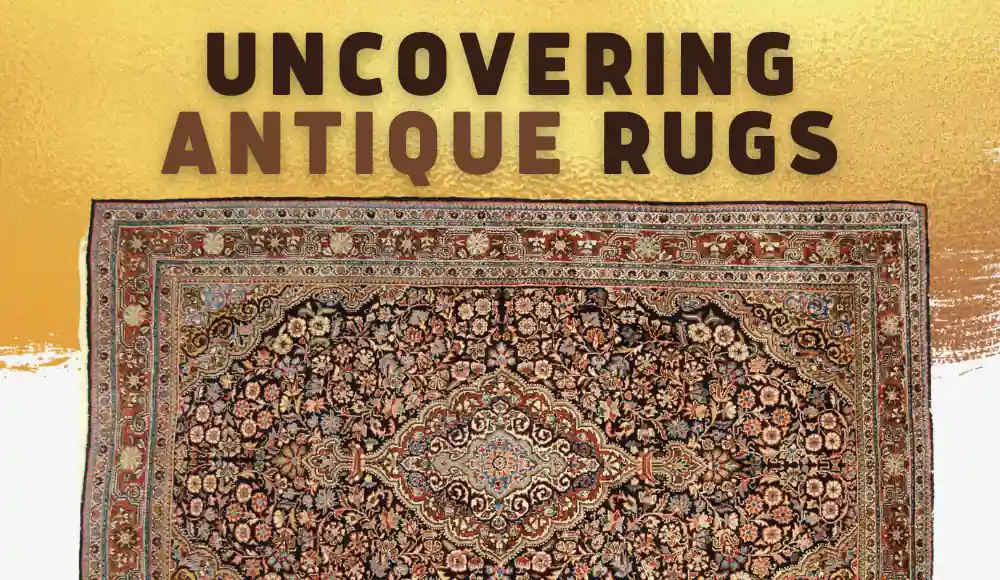Antique rugs are a window into the past, a living piece of history, and an artwork that can elevate any space. Antique rugs are rugs that have been crafted over 100 years ago and come from different regions and cultures all over the world, such as Persia, Turkey, and China.
Antique rugs have been treasured for centuries because they showcase traditional designs and techniques that have been passed down through generations.
These beautiful pieces combine artistry, beauty, and practicality to create a unique decorative element in any room. The value of antique rugs lies in their rarity and cultural significance.
They are much more than just floor coverings; they are precious works of art that embody the heritage and traditions of their makers. Antique rugs offer insights into the lives, beliefs, customs, and aesthetic values of those who crafted them.
Antique rug collectors appreciate the intricate designs, vibrant colors, and superior craftsmanship involved in creating each rug. The combination of design complexity and rarity makes antique rugs highly sought after by collectors around the world who seek to add these timeless treasures to their collections.
The History of Antique Rugs
Origin and Evolution of Rug Making
The history of rugs dates back to ancient times, with evidence of rug-making found in various civilizations such as ancient Egypt, Persia, and China. The first rugs were made from animal hides and fur to provide warmth and comfort.
Over time, the techniques evolved to include the use of wool, silk, and cotton threads for weaving intricate designs. As trade routes expanded and cultures interacted with one another, rug making techniques spread throughout the world.
This resulted in unique styles emerging in different regions known for their expertise in rug making.
For example, Persian rugs are known for their intricate patterns and color combinations while Turkish rugs often feature bold geometric designs.
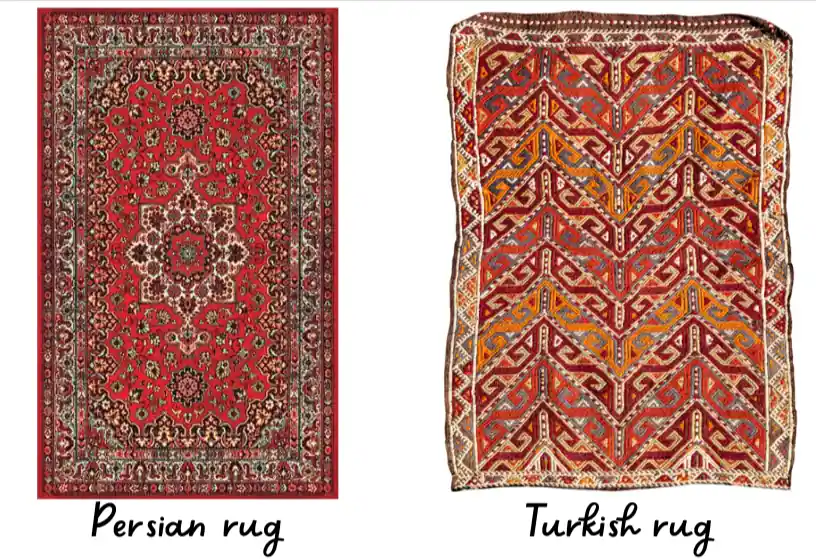
The Role of Rugs in Different Cultures Throughout History
Rugs played a significant role in many cultures throughout history. In ancient times, they were used as floor coverings to provide warmth during cold winters. They also served as decorative pieces that added color and texture to homes.
In some cultures like Persia or Turkey, owning a rug was a sign of wealth and status. Rugs were often used as gifts or dowries for marriages because they were considered valuable possessions that could be passed down from generation to generation.
Rugs also had practical uses beyond home decor. In nomadic tribes like the Berbers of North Africa or the Bedouins of the Middle East, rugs were used as tents or walls for privacy.

Overall, antique rugs have a rich history that reflects not only cultural practices but also artistic expression through intricate designs and weaving techniques.
Understanding this history adds value to these timeless pieces that continue to be coveted by collectors around the world.
Types of Antique Rugs
Persian Rugs: Characteristics, Designs, and Styles
When it comes to antique rugs, Persian rugs are perhaps the most popular and well-known in the world. These rugs are handmade by skilled weavers who have been weaving for generations.

Persian rugs are known for their intricate designs and high-quality wool, silk, or cotton used in their making. Apart from the quality of wool used, these rugs come in a wide range of designs and styles which can be traced back to different regions where they were made.
For example, the Tabriz rug is famous for its floral motifs while the Isfahan rug features intricate medallions. The Kashan rug is known for its curvilinear motifs while the Heriz rug has bold geometric patterns with large central medallions.
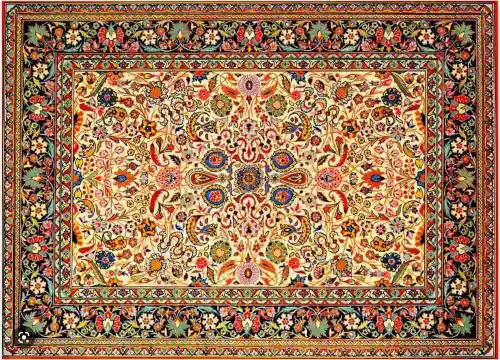
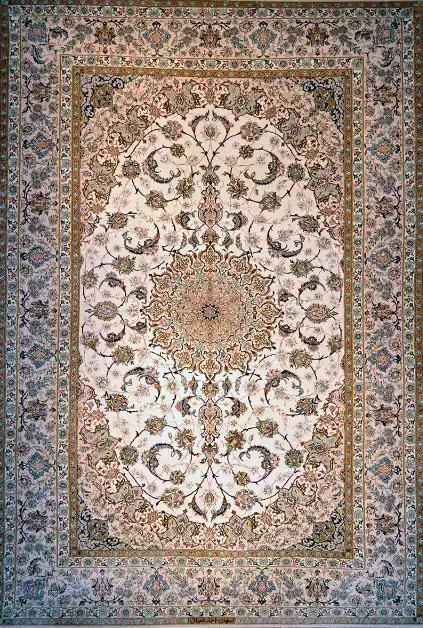
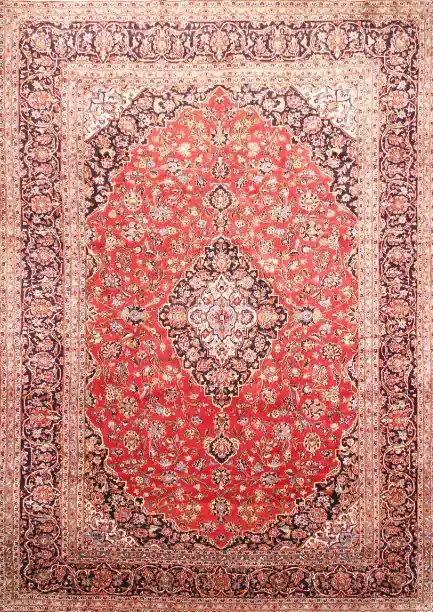
Turkish Rugs: Unique Features and Cultural Significance
Turkish rugs are another popular type of antique rug that has been exported all over the world. These rugs are known for their rich colors and unique designs which reflect Turkish culture and heritage. One notable feature of Turkish rugs is that they often have deep red or blue hues which adds warmth to any room it is placed in.
In addition to this standout feature, Turkish rugs also boast unique designs such as prayer niches or tree-of-life motifs that symbolize religious beliefs or cultural ideals.
What is a Tree of Life rug? In various cultures, a tree of life is a symbol that represents the interconnectedness of all living things, the continuity of life, and the idea of growth and renewal. The tree of life rug is not only a beautiful and eye-catching piece of decor but also carries symbolic meaning. It can serve as a reminder of the importance of connection, growth, and renewal in our lives.
Turkish carpets were also a significant part of social life; they were gifted during weddings or used as dowries with brides taking them to their new homes upon marriage.
Other Types: Caucasian, Indian, Chinese, etc.
Apart from Persian and Turkish antique carpets there exist other types as well like Caucasus which incorporates bold geometric patterns with bright hues (resembling tribal art).
Indian antique carpets on the other hand feature animal figures like elephants or tigers (thanks to India’s rural past), while Chinese carpets are known for their subtle designs (like cherry blossoms) that reflect the country’s ancient, serene culture.
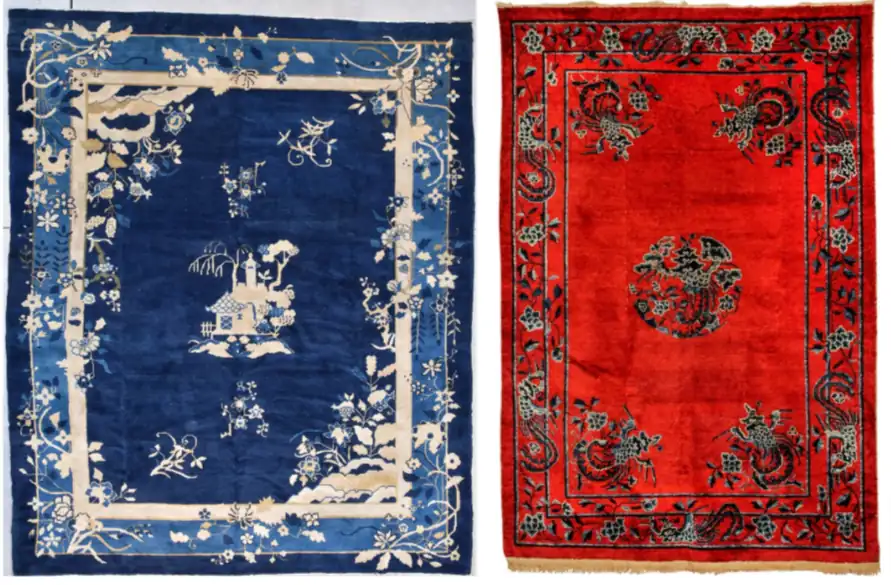
Regardless of the type or style, antique rugs have a unique way of transporting you through time and space. Each rug reflects a different culture and history, and this is one of the reasons why they are such valuable pieces.
The Artistry of Antique Rugs
Techniques used in rug making
Antique rugs are not just beautiful, but they’re also a testament to the skill and expertise of the artisans who crafted them. The techniques used to make these rugs have been passed down for generations, and it’s incredible to witness how handcrafted each rug is.

One technique used in antique rug making is hand-knotting, where individual knots are tied onto a warp string to create a design. This process is very time-consuming and requires precision, but the end result is stunning.
Another technique used in antique rug making is flat-weaving, where yarns are woven together on a loom without any knots. This method allows for greater flexibility in terms of design and pattern-making.
Flat-weaving can be seen in kilims, which are flat-woven rugs originating from Turkey and other parts of the Middle East. These rugs often feature intricate geometric or floral designs.
Design elements and motifs commonly found in antique rugs
Design elements found in antique rugs can range from simple geometric shapes to elaborate floral patterns that tell stories of cultural significance. One commonly found design element is the medallion design, which features a central medallion surrounded by smaller designs or motifs.

Medallions can be circular or diamond-shaped and may be symmetrical or asymmetrical.
Floral motifs are also common in antique rugs, with some designs featuring realistic depictions of flowers while others use stylized abstract shapes to represent flowers or leaves.
The meaning behind these designs varies depending on the culture they come from; for example, Persian rugs often feature stylized representations of flowers as symbols of rebirth and renewal.
Overall, antique rugs’ artistry reflects both their cultural roots and the skilled craftsmanship that went into their creation – resulting in stunning pieces that continue to captivate admirers today.
Caring for Antique Rugs
Antique rugs are not just ordinary items that add color and texture to a room; they are valuable works of art that require special care and attention. Proper cleaning and maintenance will preserve the beauty of the rug, prevent damage, and ensure its longevity. Here are some tips for caring for antique rugs.
Tips for Cleaning Antique Rugs
One of the most important things you can do to care for an antique rug is to keep it clean. Dirt, dust, and debris can wear away at the fibers over time, causing damage that is difficult or impossible to repair. Here are some tips for cleaning antique rugs:
- Vacuum regularly: Use a low-power vacuum with a soft-bristle attachment to remove dirt and dust from the surface of the rug. Be careful not to use too much suction or too much pressure, as this can damage delicate fibers.
- Spot clean stains: If your rug has a stain, try using a mild detergent or vinegar solution to remove it. Blot gently with a clean cloth until the stain disappears.
- Avoid harsh chemicals: Harsh chemicals like bleach or ammonia can cause irreparable damage to antique rugs. Stick with gentle cleaners specifically designed for use on delicate fabrics.
How to Store Antique Rugs Properly
Storing antique rugs properly is essential if you want them to last for generations. The following tips will help you protect your investment:
- Roll rather than fold: To prevent creases or cracking in the fiber, always roll an antique rug rather than folding it.
- Use acid-free paper: Acid-free paper creates a barrier between the rug and any harmful contaminants in its environment.
- Store in a dry location: Dampness can cause mold growth which is not only damaging but also irreversible.
- Avoid direct sunlight: Prolonged exposure to sunlight can cause fading, discoloration, and weakening of the fibers in antique rugs.
If possible, store the rug in a dark location or use UV-resistant window treatments. By following these tips, your antique rug can remain beautiful and valuable for years to come.
Investing in Antique Rugs
Antique rugs are not only beautiful pieces of art, but they can also be considered as valuable investments. The value of an antique rug is affected by many factors, such as age, rarity, size, condition, and origin. Generally speaking, the older a rug is and the better its condition, the more valuable it will be.
However, there are some specific characteristics that can add to or detract from a rug’s value. Rare designs and color combinations can increase a rug’s value significantly.
For example, antique Persian rugs with medallion patterns or silk highlights are highly sought after by collectors. Likewise, rare colors like celadon green or indigo blue can also add to a rug’s worth.
Factors that affect the value of antique rugs
Apart from design and coloration choices that impact a rug’s value greatly; there are other factors to consider when investing in antique rugs:
- Size – A larger-sized carpet is usually more expensive than a smaller one due to the amount of material required for manufacturing it.
- Rarity – Some types of carpets from specific regions become rarer over time due to loss over time; which leads to high demand for their presence.
- Age – The older a carpet generally adds more value as they become rarer over time.
- Condition – Ideally if you’re looking for an investment you want to go for carpets in excellent condition with minimal wear tear or repair needed; spending money on restoration before investing will often result in losses.
- Origin – Antique carpets made in Iran (Persian), Turkey (Ottoman), India (Mughal), and China (Ming/Qing) have been popular among collectors for centuries and hence their origins play an important role in determining the overall value of a rug.
How to identify authentic antique rugs
For instance, what is considered an antique Persian rug?
Identifying an authentic antique rug can be challenging, but there are some tips and tricks that can help. First, examine the rug closely for any signs of wear and tear. Authentic antique rugs should show some signs of age, such as fading or discoloration.
Second, look at the knots on the back of the rug. Genuine antique rugs will have asymmetrical knots that are usually uneven in size; modern-day rugs often have symmetrical knot patterns.
Additionally, pay attention to any labels or tags on the rug. Many rugs will have a label indicating where and when they were made, or by whom they were made which provides important context for understanding the history of the piece itself!
Seek professional help if you’re not quite confident. Antique rug experts are happy to lend their expertise and knowledge about specific carpets that you may be interested in buying; usually, it is best to purchase from a reputable dealer who guarantees authenticity or provides full disclosure with respect to any restorations performed on them.
Famous Antique Rug Collections Around the World:
Exploring the Treasury of Antique Rugs at the Metropolitan Museum
The Metropolitan Museum of Art in New York has one of the world’s largest collections of antique rugs.
The collection includes over 14,000 pieces from around the world, some dating as far back as 2500 BCE. The rugs at the Metropolitan Museum of Art are not only beautiful but also historically significant, providing a glimpse into different cultures and weaving techniques.
One notable piece in their collection is a 16th-century Persian rug known as “the Clark Sickle-Leaf carpet”. This particular design has inspired many other rugs over time and has helped establish certain motifs that are still used today.
The Topkapi Palace Museum’s Exquisite Antique Rugs
The Topkapi Palace Museum in Istanbul is another renowned location for antique rug collections. Built in the 15th century, it served as a residence for Ottoman sultans until the mid-19th century.
Medallion Ushak
Another notable piece is “Medallion Ushak,” a late 17th-century Turkish carpet featuring an abstract medallion and floral motifs that inspired many other designs during its time.
“The Hereke Carpet”
In 2020 a 123-year-old Hereke carpet underwent a process of restoration. It was woven in 1897 on the order of Ottoman Sultan Abdülhamid II. The famous historical Turkish carpet weighs 3 tons and is “the largest one-piece weave” carpet in Turkey.
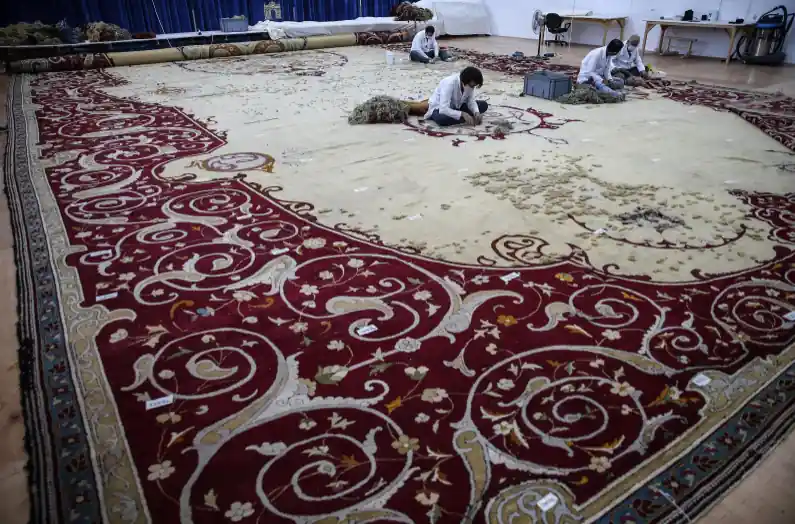
These are just two examples of famous locations where you can find extraordinary antique rug collections to explore and appreciate their beauty and historical value alike. From Persia to Turkey, India to China, antique rugs have a timeless appeal that will always be fascinating to those who appreciate art and history.
Conclusion: A Timeless Investment and Masterpiece of Art
Antique rugs have a rich history, undeniable beauty, and unique cultural significance. From the intricate designs to the impressive craftsmanship, antique rugs are worth exploring for anyone interested in art, history, or design.
These timeless pieces are a testament to the talent and creativity of their makers, as well as the cultures that influenced them.
As we’ve explored in this article, antique rugs come in various designs and styles from different parts of the world such as Persian, Turkish, or Caucasian. Each rug tells a story and has its own character that makes it unique.
Investing in an authentic antique rug is not only owning a piece of art but also owning a piece of history. Antique rugs can add sophistication and grandeur to any room they’re placed in.
They bring warmth and texture to the modern decor while also adding cultural depth. The beauty of an antique rug is that it can stand alone as a statement piece or perfectly complement other decor elements.
Whether you’re buying an antique rug for investment purposes or simply appreciating its aesthetics, owning one is an experience that transcends time. Exploring the world of antique rugs offers limitless possibilities for discovery and appreciation.
With patience, knowledge, and care – one can own a priceless masterpiece that will last for generations to come. These enchanting pieces not only beautify our surroundings but also give us a glimpse into different cultures throughout history – making them all more valuable than just their monetary worth alone.
